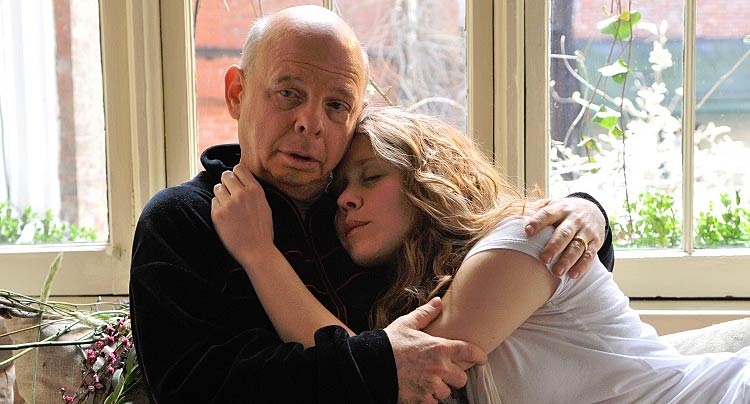
Themes of guilt shine through, but the flawed final product makes for a frustrating watch.

Themes of guilt shine through, but the flawed final product makes for a frustrating watch.
At the start of A Master Builder, successful architect Halvard Solness (Wallace Shawn) is on his deathbed. He looks weak, until a conversation with fellow architect Knut (André Gregory) reveals his ruthless nature. Knut wants his son Ragnar (Jeff Biehl), a lowly worker of Solness, to finally get the opportunity to become an architect himself. Solness cruelly shoots the idea down. He’s intimidated by Ragnar’s talent as an architect, keeping him in a low-level position to make sure he won’t have any competition. Just to make sure things stay the same, Solness employs Ragnar’s fiancée Kaya (Emily McDonnell) as his bookkeeper while sleeping with her on the side. With Kaya devoted to Solness and her job, Ragnar won’t consider leaving his.
The harshness of the situation immediately changes with a knock on the door. In walks Hilde (Lisa Joyce), a young, vivacious beauty. Solness excitedly welcomes her, while his wife Aline (Julie Hagerty) reacts coldly. Hilde and Solness met each other a decade earlier, something he doesn’t recall until she reminds him. There’s an implication that Hilde was molested by Solness (she was 12 at the time), but the film doesn’t clarify whether it actually happened. Hilde inserts herself into the lives of Solness and Aline, with Solness having long conversations with her about his life.

The text and story of A Master Builder naturally shine because of its origins. The film adapts a classic play from Henrik Ibsen, with Wallace Shawn translating the original text and writing the screenplay. The movie is a continuation of filmed collaborations between Shawn and André Gregory, first seen in Louis Malle’s My Dinner with Andre and Vanya on 42nd Street. Jonathan Demme takes directing duties here, his first fiction feature in six years. The film’s opening, with Solness on his deathbed, replicates the handheld style of Rachel Getting Married until Hilde arrives. Demme changes the aspect ratio from 16×9 to Cinemascope, swaps the pale color palette for warm hues and starts shooting in a more conventionally bland style.
The clever visual trick at the top of the film appears to be Demme’s only real directorial flourish here. It’s understandable why he would prefer to take a step back, letting the script and talented cast do what they do best. Instead it makes for restless viewing, as the exchanges between Solness and Hilde unfold in a visually uninteresting shot reverse shot style. Demme’s seemingly hands off approach also brings attention to the uneven acting. Shawn feels miscast as the central character, portraying a controlling genius with two young, beautiful women pining for him. Performances are constantly overtheatrical, and despite the cast clearly making an effort their work is too wildly distracting. Joyce’s repeated outbursts of loud, hysterical laughter will most likely confuse viewers or get on their nerves.
Thankfully Ibsen’s material, and Shawn’s screenplay, prevent the film from tanking. In the second act Solness explains to Hilde why his marriage is so damaged. Decades earlier their house burned down, and soon after their two infant children died tragically. Solness only sees his tragedies as more of a trade, though; he was able to use the vacant lot where his house stood as an opportunity to sell lots and build his designs, earning him the status of “Master Builder.” He looks at it as a cosmic balance, gaining the success he desired from intense misfortune, and therefore taking responsibility for everything. The film’s themes of guilt shine through, but the flawed final product makes A Master Builder frustrating to watch.